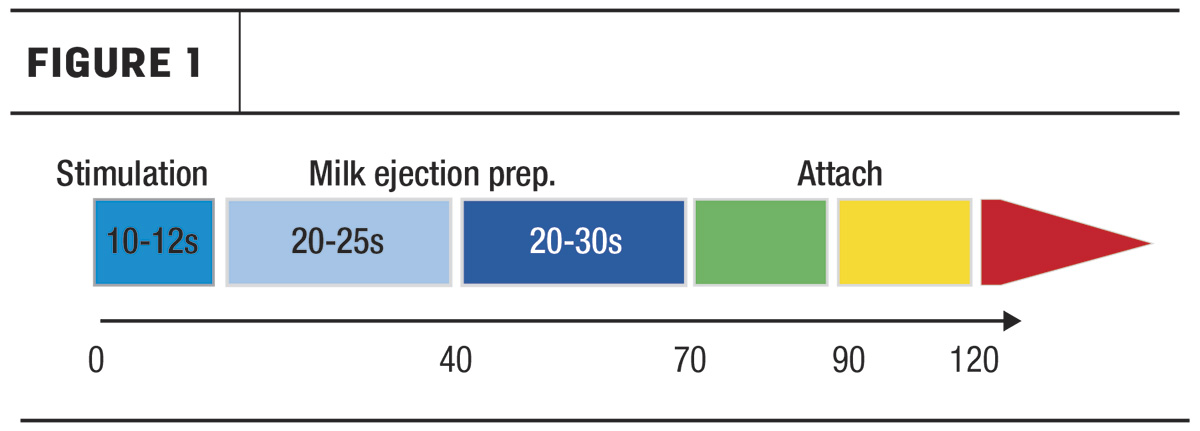Your cows have a natural process to let their milk down. After some stimulation (touch, sound of a calf, etc.), they release oxytocin, which causes muscle contractions that squeeze the milk in the udder’s alveoli (milk-producing unit) to the udder cistern.
A good milk letdown is what leads to faster milking speeds, not the other way around. So how can you lead your herd into a good letdown to see top speeds and improved milk production?
Stress impacts milk letdown
If you have a cow that is holding milk, it is probably because she is stressed. Stress releases cortisol and beta-endorphins, which can reduce or completely block the flow of oxytocin.
This interference leads to a delayed letdown. You may still be able to harvest 20% of the milk, which is stored in the cistern of the milk gland. To get the milk that is still deep in the milk gland, you will need a release of oxytocin. That can happen after you put the machine on and harvest the cisternal milk, but this will result in bimodal milking. Utilize monitoring tools designed to provide alerts and visual graphs when these potential errors occur.
What leads to stress in dairy cows? They can become stressed from:
- A new environment
- Loud, unfamiliar sounds
- Discomfort
- Anxiety
This is why heifers often take longer to milk. They are in a new environment with a foreign routine, so they need more time to become relaxed and release oxytocin.
Routine is key
For the best milk letdown, a cow needs to be happy and calm. Because they are a prey species, cows are scared of unfamiliar objects, noises and sudden movements. That is why a consistent routine to keep things predictable is so important.
Work with your veterinarian or an expert of your choice to determine the best milking routine for your dairy. Then stay consistent.
Routines for milking can include the following:
- Always milk at the same time.
- Use your hands to collect milk and to check for mastitis. This physical touch will also start milk letdown.
- Do a pre-dip.
- Wipe the udder, paying close attention to the teat end.
- Begin the milking process.
Another important part of a consistent routine is parlor maintenance. Keep equipment running with regular checks and maintenance. When equipment breaks down and delays milking, your herd and your employees will be stressed, making it harder to milk.
Also, follow replacement recommendations for your liners. Do not continue to use liners past the recommended usage just because they look good. Liners will deteriorate before damage is visible (microcracks, rubber composition, etc.), and this impacts milking performance.
Even a change in labor can throw your herd off their routine. Labor change is inevitable, but stay mindful of your standard operating procedures and how new hires are trained to avoid protocol drift. Routine employee training and retraining have a great impact on your milk quality.
Best practices to optimize milk letdown
There are three words to keep in mind when milking: gently, quickly and completely.
Move your herd through the parlor gently. You want to minimize their stress by staying calm. Do not hit, twist tails, yell or play music too loudly. Respect the cows.
Next, milk them quickly. This means using proper timing for udder preparation and attaching the milking unit (Figure 1). When this is timed correctly, you will see improved milk flow because you are taking advantage of their natural milk letdown.

Here is how the timing should go:
- 10 to 20 seconds for teat stimulation
- 20 to 25 seconds for oxytocin to reach the udder
- 20 to 30 seconds for muscles to start contracting
- 60 to 90 seconds after first contact, there is milk letdown
- 60 to 120 seconds after first contact, the milking machine should be attached
It is necessary to stimulate the teats for 10 to 12 seconds. Some cows may need very light stimulation, such as pre-dipping, while others may need a more vigorous touch, such as stripping and drying or brushing.
Do not put the milk machine on before you should. If you do, it may hurt the cow. Also, watch the milk flow. If you are running the vacuum when there is minimal milk flow, the teat-end vacuum will be too high, and you will have more chance of teat-end damage and teat-skin congestion.
Lastly, milk your herd completely. Take all the available milk, but do not overmilk. If you overmilk, you may hurt the cow and damage the teats. If you undermilk, you will make the cow produce less milk in the long run and may make some animals more prone to mastitis. When you milk correctly, your total production will most likely increase.
Unlocking top milk production
Achieving your best milk production requires understanding and working with your herd’s natural milk letdown process. When you minimize stressors and implement a consistent routine, you can optimize milk letdown and increase productivity – an achievement for you, your employees and your herd.






